Abstract
The absorption of bile acids from the human large bowel was studied in eight patients. All patients had cholecystitis and cholelithiasis and had to undergo cholecystectomy. Cholic acid-14C was injected during surgery into the lumen of the cecum, hepatic flexure of the colon, or transverse colon in six patients, under the visual control of the surgeon. Common duct bile was collected by T tube daily for 5 days, and bile acids were extracted. Significant amounts of radioactivity appeared in T tube bile in each patient. T tube bile acids contained a total of 43.6-84.6% of the administered radioactivity; the average for the six patients was 58.9%. The majority of the tracer was excreted during the first 24 hr. In an additional patient cholic acid-14C was given in the form of an enema 5 days postoperatively. In this subject 30.8% of the retained radioactivity was excreted through the T-tube in 48 hr. The labeled cholic acid was recovered as both cholic and deoxycholic acid from T tube bile. Thin-layer chromatographic analysis of the bile acid samples indicated that the fraction of radioactivity recovered as deoxycholate increased with time during the postoperative period. Gas-liquid chromatographic analysis showed that the daily total quantity of excreted bile acids increased significantly from the 1st-5th days of the experiment. The amount of cholate excreted in T tube bile increased markedly with time, that of chenodeoxycholate increased moderately, and that of deoxycholate decreased sharply during the 5 days of the experiment. In three patients, injection of radiopaque material mixed with the tracer showed no evidence of regurgitation into the small bowel by serial X-rays. In an additional patient, tube aspirate from the terminal ileum contained no radioactivity. The results indicate that cholic acid is converted to deoxycholic acid in the human colon, and both of these bile acids are absorbed from the human large bowel in significant amounts. These data establish the previously unproved concept that significant absorption of bile acids takes place from the large bowel of man.
Full text
PDF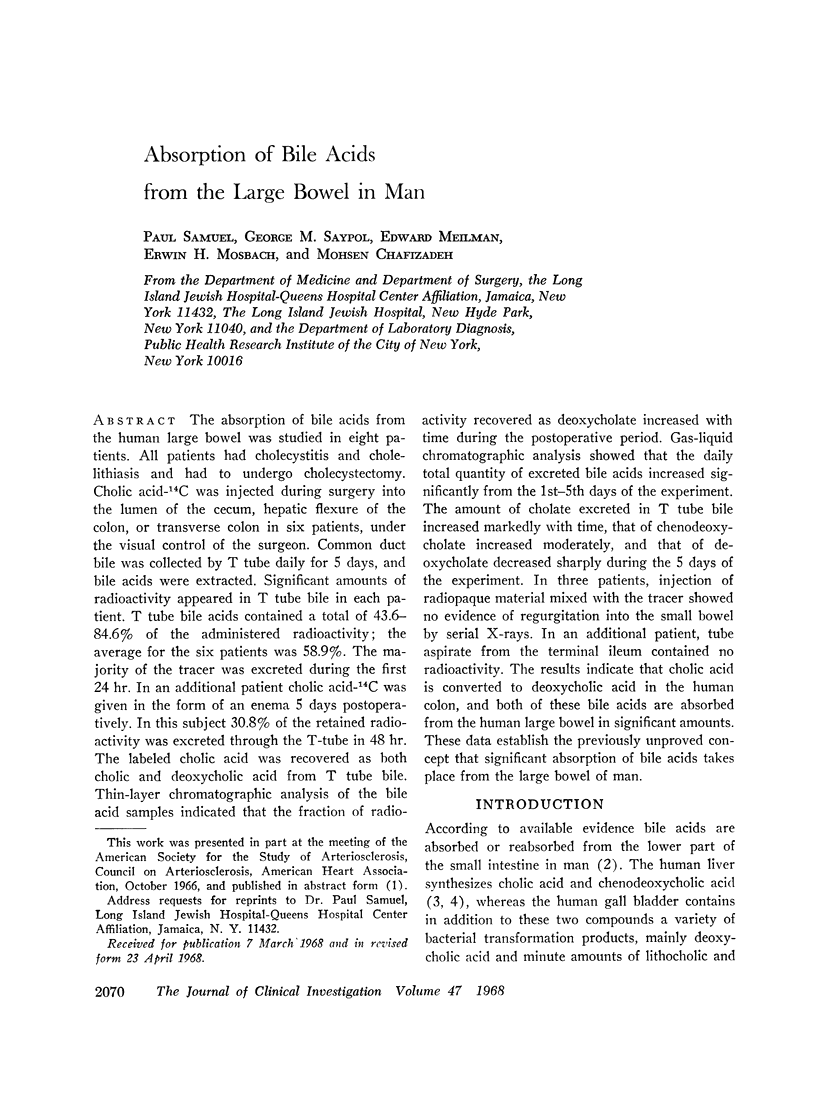


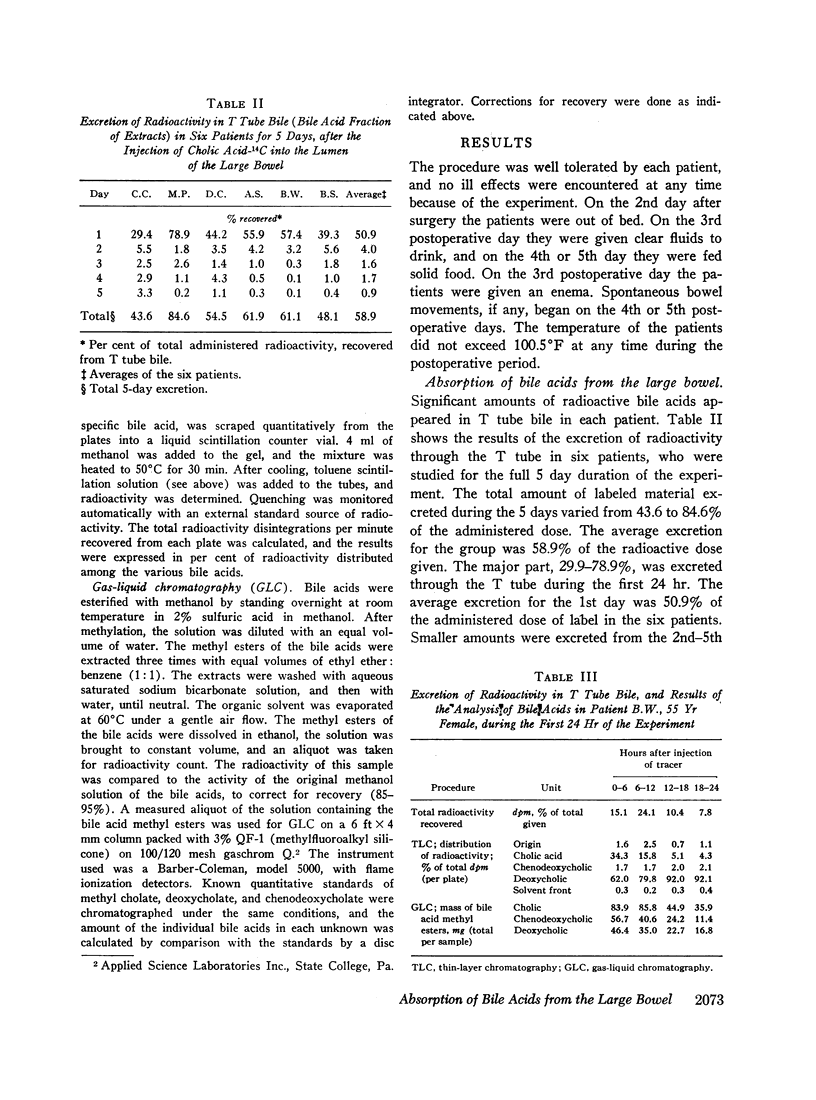
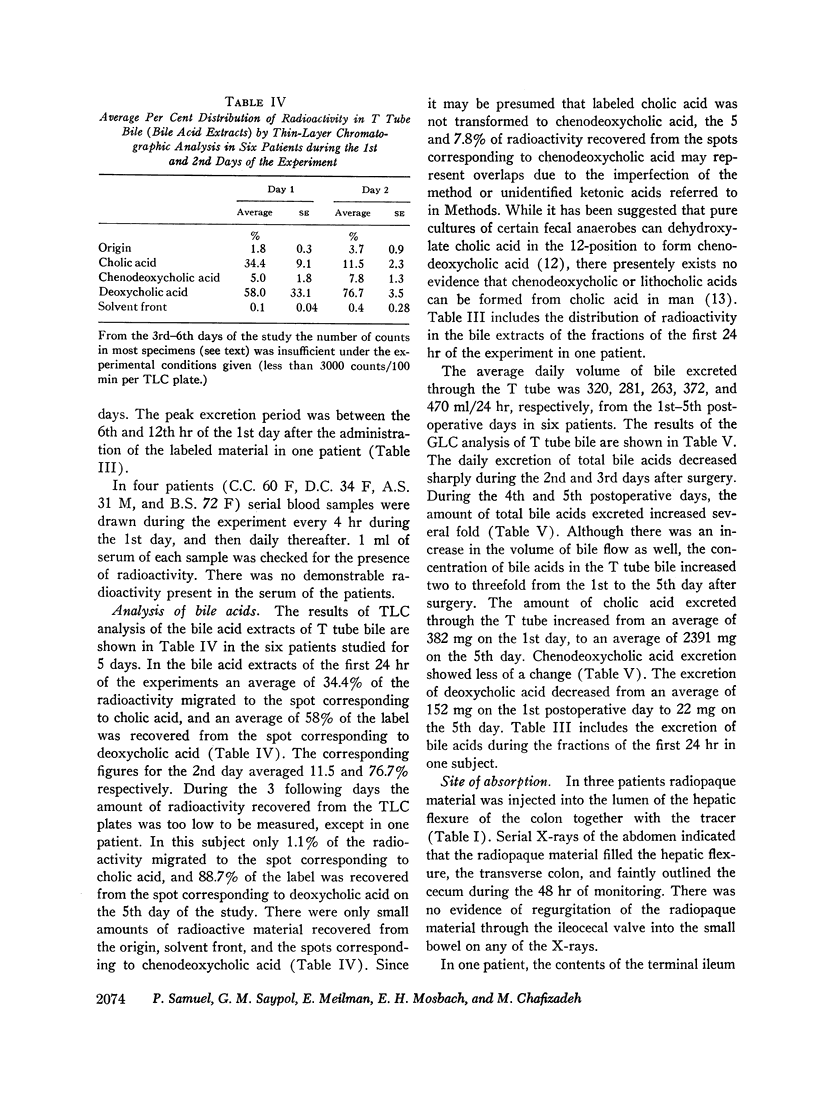

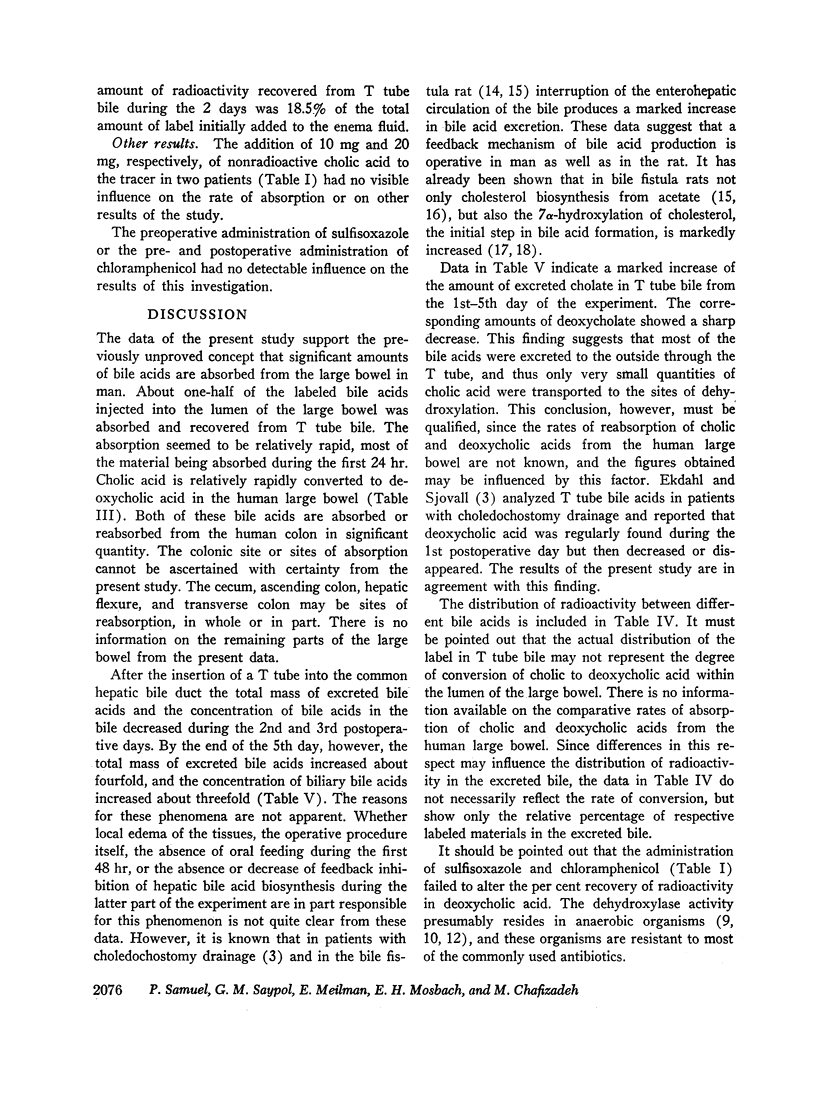

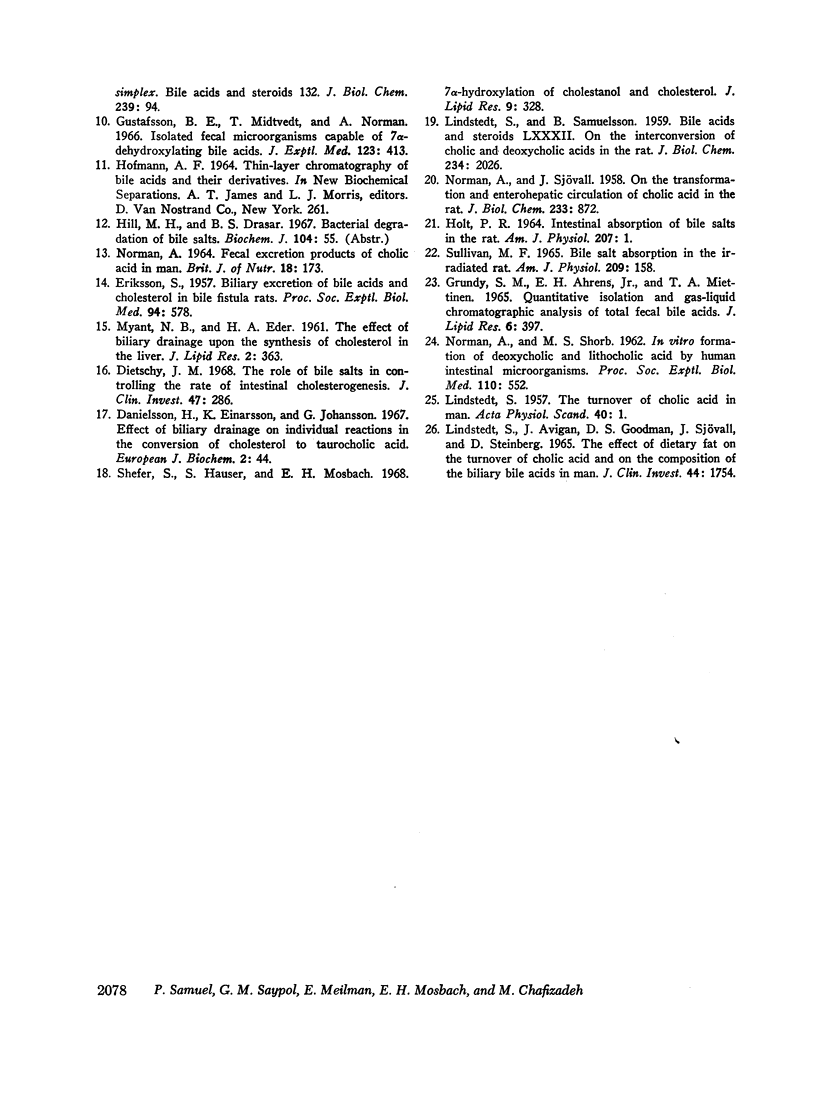
Selected References
These references are in PubMed. This may not be the complete list of references from this article.
- BORGSTROEM B., LUNDH G., HOFMANN A. THE SITE OF ABSORPTION OF CONJUGATED BILE SALTS IN MAN. Gastroenterology. 1963 Aug;45:229–238. [PubMed] [Google Scholar]
- DANIELSSON H., ENEROTH P., HELLSTROM K., LINDSTEDT S., SJOVALL J. On the turnover and excretory products of cholic and chenodeoxycholic acid in man. J Biol Chem. 1963 Jul;238:2299–2304. [PubMed] [Google Scholar]
- Danielsson H., Einarsson K., Johansson G. Effect of biliary drainage on individual reactions in the conversion of cholesterol to taurochlic acid. Bile acids and steroids 180. Eur J Biochem. 1967 Jul;2(1):44–49. doi: 10.1111/j.1432-1033.1967.tb00103.x. [DOI] [PubMed] [Google Scholar]
- Dietschy J. M. The role of bile salts in controlling the rate of intestinal cholesterogenesis. J Clin Invest. 1968 Feb;47(2):286–300. doi: 10.1172/JCI105725. [DOI] [PMC free article] [PubMed] [Google Scholar]
- EKDAHL P. H., SJOVALL J. On the conjugation and formation of bile acids in the human liver. I. On the excretion of bile acids by patients with postoperative choledochostomy drainage; bile acids and steroids 61. Acta Chir Scand. 1958 May 10;114(6):439–452. [PubMed] [Google Scholar]
- ERIKSSON S. Biliary excretion of bile acids and cholesterol in bile fistula rats; bile acids and steroids. Proc Soc Exp Biol Med. 1957 Mar;94(3):578–582. doi: 10.3181/00379727-94-23018. [DOI] [PubMed] [Google Scholar]
- GRUNDY S. M., AHRENS E. H., Jr, MIETTINEN T. A. QUANTITATIVE ISOLATION AND GAS--LIQUID CHROMATOGRAPHIC ANALYSIS OF TOTAL FECAL BILE ACIDS. J Lipid Res. 1965 Jul;6:397–410. [PubMed] [Google Scholar]
- Gustafsson B. E., Midtvedt T., Norman A. Isolated fecal microorganisms capable of 7-alpha-dehydroxylating bile acids. J Exp Med. 1966 Feb 1;123(2):413–432. doi: 10.1084/jem.123.2.413. [DOI] [PMC free article] [PubMed] [Google Scholar]
- HAYAKAWA S., SAMUELSSON B. TRANSFORMATION OF CHOLIC ACID IN VITRO BY CORYNEBACTERIUM SIMPLEX. BILE ACIDS AND STEROIDS. 132. J Biol Chem. 1964 Jan;239:94–97. [PubMed] [Google Scholar]
- HELLSTROM K., SJOVALL J. On the origin of lithocholic and ursodeoxycholic acids in man. Bile acids and steroids 106. Acta Physiol Scand. 1961 Feb-Mar;51:218–223. doi: 10.1111/j.1748-1716.1961.tb02130.x. [DOI] [PubMed] [Google Scholar]
- HOLT P. R. INTESTINAL ABSORPTION OF BILE SALTS IN THE RAT. Am J Physiol. 1964 Jul;207:1–7. doi: 10.1152/ajplegacy.1964.207.1.1. [DOI] [PubMed] [Google Scholar]
- LINDSTEDT S., SAMUELSSON B. Bile acids and steroids. LXXXIII. On the inter-conversion of cholic and deoxycholic acid in the rat. J Biol Chem. 1959 Aug;234(8):2026–2030. [PubMed] [Google Scholar]
- LINDSTEDT S. The turnover of cholic acid in man: bile acids and steroids. Acta Physiol Scand. 1957 Sep 17;40(1):1–9. doi: 10.1111/j.1748-1716.1957.tb01473.x. [DOI] [PubMed] [Google Scholar]
- Lindstedt S., Avigan J., Goodman D. S., Sjövall J., Steinberg D. The effect of dietary fat on the turnover of cholic acid and on the composition of the biliary bile acids in man. J Clin Invest. 1965 Nov;44(11):1754–1765. doi: 10.1172/JCI105283. [DOI] [PMC free article] [PubMed] [Google Scholar]
- NORMAN A. FAECAL EXCRETION PRODUCTS OF CHOLIC ACID IN MAN. Br J Nutr. 1964;18:173–186. doi: 10.1079/bjn19640017. [DOI] [PubMed] [Google Scholar]
- NORMAN A., GRUBB R. Hydrolysis of conjugated bile acids by Clostridia and enterococci; bile acids and steroids 25. Acta Pathol Microbiol Scand. 1955;36(6):537–547. doi: 10.1111/j.1699-0463.1955.tb04651.x. [DOI] [PubMed] [Google Scholar]
- NORMAN A., PALMER R. H. METABOLITES OF LITHOCHOLIC ACID-24-C-14 IN HUMAN BILE AND FECES. J Lab Clin Med. 1964 Jun;63:986–1001. [PubMed] [Google Scholar]
- NORMAN A., SHORB M. S. In vitro formation of deoxycholic and lithocholic acid by human intestinal microorganisms. Proc Soc Exp Biol Med. 1962 Jul;110:552–555. doi: 10.3181/00379727-110-27577. [DOI] [PubMed] [Google Scholar]
- NORMAN A., SJOVALL J. On the transformation and enterohepatic circulation of cholic acid in the rat: bile acids and steroids 68. J Biol Chem. 1958 Oct;233(4):872–885. [PubMed] [Google Scholar]
- PORTMAN O. W., SHAH S., ANTONIS A., JORGENSEN B. Alteration of bile salts by bacteria. Proc Soc Exp Biol Med. 1962 Apr;109:959–965. doi: 10.3181/00379727-109-27391. [DOI] [PubMed] [Google Scholar]
- SULLIVAN M. F. BILE SALT ABSORPTION IN THE IRRADIATED RAT. Am J Physiol. 1965 Jul;209:158–164. doi: 10.1152/ajplegacy.1965.209.1.158. [DOI] [PubMed] [Google Scholar]
- Shefer S., Hauser S., Mosbach E. H. 7-alpha-hydroxylation of cholestanol by rat liver microsomes. J Lipid Res. 1968 May;9(3):328–333. [PubMed] [Google Scholar]


